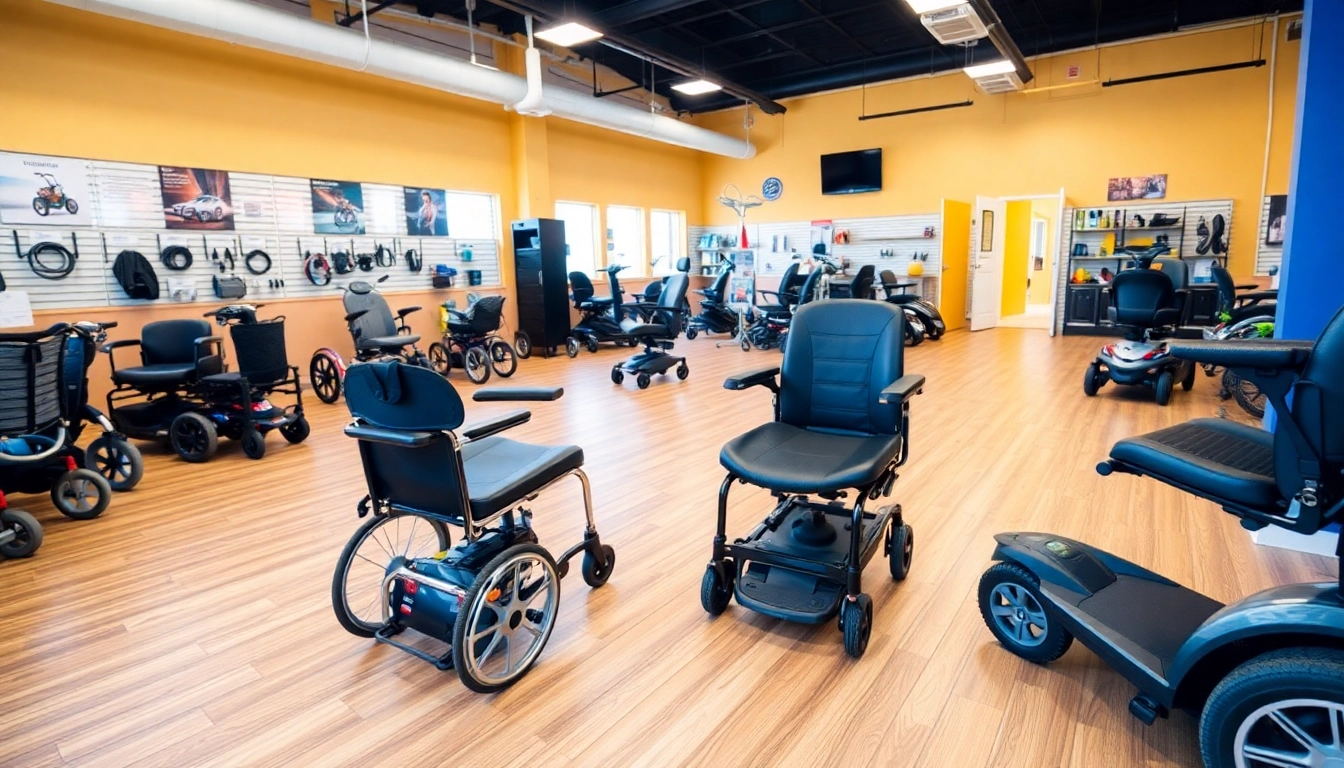Understanding Mobility Equipment
Mobility equipment plays a crucial role in enhancing the quality of life for individuals with mobility challenges. These devices are designed to provide support, improve accessibility, and promote independence. Whether due to age, injury, or a medical condition, many people find that mobility aids allow them to engage more fully in daily activities, social interactions, and personal pursuits. At the core of this discussion is the importance of selecting the right mobility equipment that meets individual needs and enhances daily living.
What is Mobility Equipment?
Mobility equipment encompasses a diverse range of devices that assist individuals in moving around effectively and safely. These aids can range from simple walking supports, like canes and walkers, to more complex options such as powered wheelchairs and mobility scooters. The primary goal of mobility equipment is to improve the autonomy of users and their ability to perform everyday tasks without excessive effort or risk of falls and injuries.
Types of Mobility Aids
Mobility aids can be categorized based on their functionality and the level of support they provide. Here are some common types:
- Canes: Simple yet effective tools designed to provide support and balance for individuals who may need assistance while walking.
- Walkers: Provide more stability than a cane, featuring four legs for sturdy support. They come with options such as wheeled walkers, enabling users to move easily without lifting.
- Wheelchairs: Available in both manual and powered varieties, wheelchairs allow individuals to navigate their environments with ease, particularly when walking is challenging.
- Mobility Scooters: Battery-operated vehicles that enable users to travel longer distances while requiring minimal physical exertion.
- Lift Chairs: Recliner chairs that assist users in getting up and sitting down, ideal for those with limited mobility.
Benefits of Mobility Equipment
The advantages of mobility equipment are multifaceted, impacting not just physical health but also emotional well-being. Some benefits include:
- Increased Independence: One of the most significant advantages is enhanced autonomy. With the right mobility aids, individuals can perform everyday tasks and activities without relying on others.
- Improved Safety: Mobility equipment reduces the risk of falls and injuries, offering users a safer means of moving around their home or community.
- Enhanced Quality of Life: The use of mobility aids leads to better participation in social activities, allowing individuals to maintain relationships and engage in enjoyable experiences.
- Physical Health Benefits: Regular movement supported by mobility aids can contribute to improved physical health, maintenance of muscle strength, and better overall wellness.
Choosing the Right Mobility Equipment
Assessing Individual Needs
Selecting the appropriate mobility equipment starts with understanding personal needs and preferences. This includes considering factors such as the type of mobility issues experienced, the environments where the equipment will be used, and personal lifestyle. An effective assessment involves analyzing:
- The extent of mobility limitations: differentiating between needs for short bursts of assistance and sustained support.
- Home layout and accessibility: identifying areas where the user intends to navigate, such as narrow hallways, stairs, or uneven surfaces.
- Comfort and ease of use: ensuring that the equipment will be comfortable to use over longer periods and simple to operate.
Consulting with Healthcare Professionals
Before making a decision on mobility equipment, it’s essential to consult with healthcare providers. Physicians, occupational therapists, and physical therapists can offer expert recommendations based on clinical assessments. They can help identify the most suitable equipment and train individuals on how to use it properly. Collaborating with healthcare professionals ensures that the chosen mobility aid addresses all safety and functional requirements, leading to better outcomes.
Evaluating Product Features
When exploring different mobility aids, it’s critical to evaluate product features carefully. Here are some key considerations:
- Weight Capacity: Ensure that the mobility equipment can safely accommodate the user’s weight.
- Portability: Assess whether the equipment is easy to transport, especially if the user will need to travel frequently.
- Adjustability: Look for features that allow customization, such as height-adjustable handles or removable seats.
- Batteries: For electric mobility aids, consider battery life and recharge options to ensure it meets daily usage requirements.
- Safety Features: Check for features such as anti-tip mechanisms, effective brakes, or reflective elements for improved visibility.
Popular Mobility Equipment Options
Wheelchairs: Types and Uses
Wheelchairs are among the most recognized forms of mobility equipment and come in various designs tailored to different user needs. The two primary categories include:
- Manual Wheelchairs: These require the user to propel themselves using hand rims. They are ideal for individuals who have upper body strength and want to maintain an active lifestyle. They can be folded for easy transport and storage.
- Powered Wheelchairs: These are operated via joystick or other control methods and are suitable for individuals unable to self-propel. They offer more comfort and support for extended use and often include advanced features like reclining seats or leg rests.
The choice between manual and powered options largely depends on the user’s level of mobility, lifestyle, and preferences.
Scooters: A Convenient Solution
Mobility scooters provide an excellent alternative for individuals who struggle with walking but still wish to maintain a sense of independence. Perfect for navigating larger spaces like shopping centers or community areas, scooters come equipped with features such as:
- Adjustable tillers for user comfort.
- Storage compartments for personal items.
- Robust battery systems that allow for longer travel distances.
- Padded seating and armrests for enhanced comfort during use.
Selecting a scooter involves considering factors such as the intended use, terrain type, and the user’s ability to control the device.
Walkers and Canes: Supportive Tools
Both walkers and canes offer valuable support for individuals needing assistance, providing critical balance and stability. Walkers typically feature a sturdy frame with four legs and are beneficial for those who require more support. Alternatively, canes are more portable and offer lightweight support for those who experience occasional instability.
Walkers come in several styles, including:
- Standard Walkers: Basic models with no wheels that require users to lift the walker to move.
- Wheeled Walkers: Equipped with two or four wheels for easier mobility.
- Rollators: Walkers with a built-in seat that allows users to rest when fatigued.
Users should consider their specific mobility needs and comfort when selecting between these options.
Maintaining Your Mobility Equipment
Regular Checks and Services
Proper maintenance of mobility equipment is essential for ensuring its longevity and safety. Regular checks should be performed to inspect components such as:
- Tires and wheels ensuring they are in good condition and appropriately inflated where applicable.
- Brakes and safety features to ensure they function correctly.
- Electronics in powered devices to confirm battery performance remains optimal.
Scheduled servicing by trained technicians can also help identify issues before they become significant problems, contributing to safety and extending the lifespan of the equipment.
Cleaning and Care Tips
Keeping mobility equipment clean is not only about aesthetics; it also ensures functionality and hygiene. Here are some essential cleaning and care tips:
- Use a damp cloth to wipe down frames and seats, ensuring that no moisture accumulates in electrical components.
- Regularly check and clean wheels or casters to ensure smooth operation.
- Inspect upholstery and fabric components for wear and clean them according to the manufacturer’s instructions.
In addition to regular cleaning, users should safeguard their equipment against unnecessary wear by storing it in appropriate, dry environments when not in use.
When to Replace Equipment
Understanding when to replace mobility equipment can significantly impact the user’s safety and comfort. Signs that it may be time for a replacement include:
- Visible wear and tear, such as rust or breaks in the frame.
- Functional issues, such as wheels that don’t turn correctly or brakes that fail to engage.
- A decrease in comfort or an inability to meet current mobility needs due to changing physical conditions.
Staying proactive about replacements can prevent accidents and ensure the best support for the user’s mobility needs.
Modern Innovations in Mobility Equipment
Technological Advancements
The mobility aid industry has seen significant advancements in technology, leading to more functional, user-friendly products. Innovations include lighter materials that enhance portability, advanced battery systems that provide longer usage without change, and more ergonomic designs that prioritize user comfort. These innovations aim to address the evolving needs of diverse populations while ensuring safety and ease of use.
Smart Mobility Devices
Smart technology has reached the realm of mobility equipment, resulting in the emergence of smart mobility devices, such as:
- App-Controlled Wheelchairs: Offering features like remote operation, programmable routes, and performance monitoring through mobile applications.
- Connected Mobility Scooters: Providing GPS navigation and alerts for maintenance needs, enhancing user experience and safety.
- Sensor-Based Walkers: Integrated sensors can detect when a user is losing balance and provide alert signals or stability assistance.
These advancements will continue to redefine mobility, enhancing the capabilities and independence of users.
Future Trends in Mobility Solutions
Looking to the future, several trends are anticipated in mobility equipment development, including:
- Customization: Tailoring mobility devices to meet individual needs and preferences, enhancing comfort and usability.
- Telehealth Integration: Additional features may allow healthcare professionals to monitor patient mobility through connected devices, providing insights into health and safety.
- Eco-Friendly Materials: The development of sustainable materials for production, reducing environmental impact.
As mobility technology continues to evolve, we can expect these innovations to create more advanced solutions aimed at increasing independence and improving overall quality of life.



